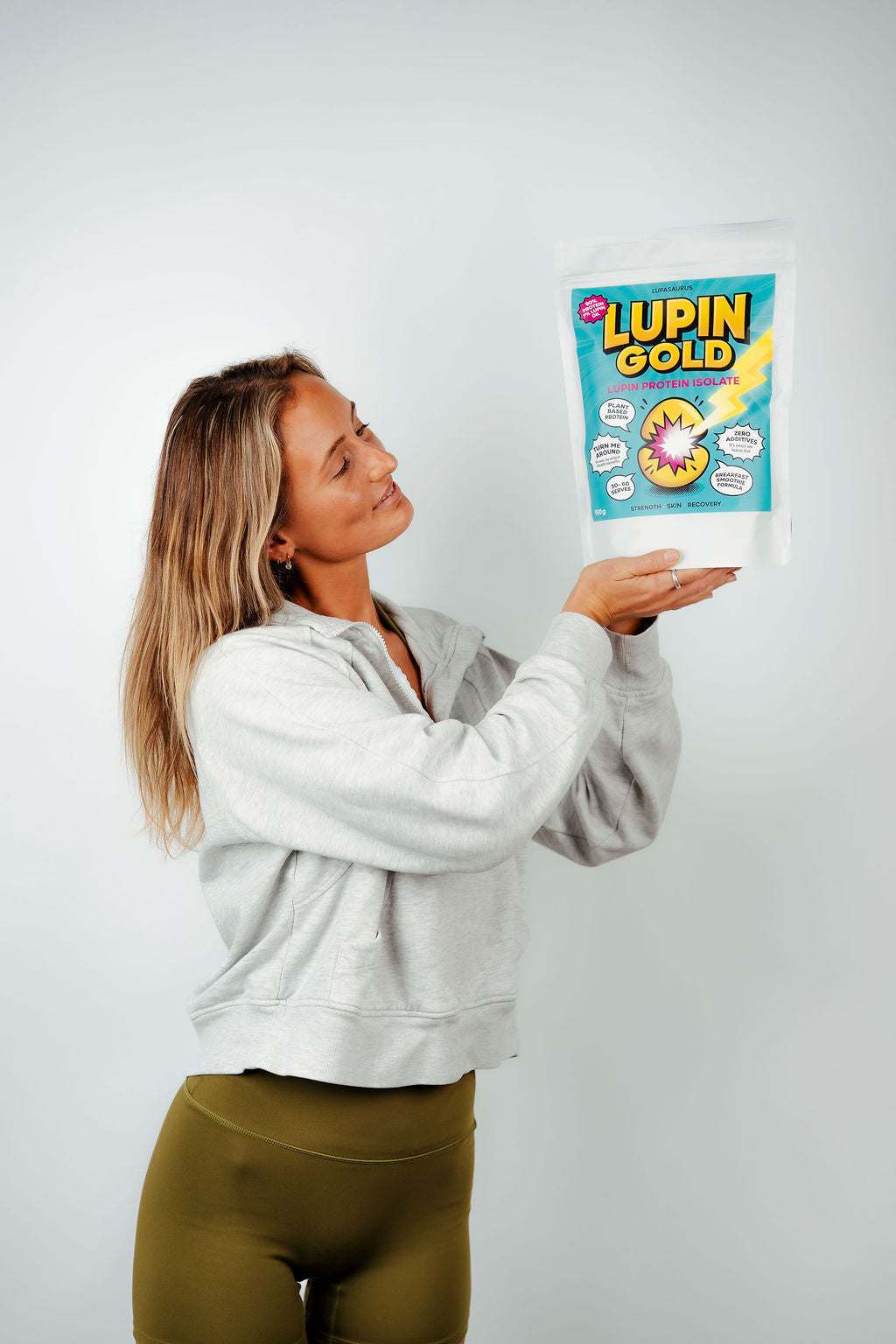We’re Harvie & Kobi, the founders of Lupin Gold, and yes, we deliberately chose an ingredient with a few strings attached. Why? Because of the benefits; high protein quality, gut-friendliness, versatility, and sustainability. They far outweigh the risks when you understand them. Risk doesn’t mean avoidance; it means staying one step ahead. What you should know about Lupin Gold is that "allergen" has been reduced to "TRACE" (almost non-existent) levels due to the new and patented refinement technology... The kettle is on, let’s walk through the science and the facts.

So… Is Lupin an Allergen? (Short Answer: Yes.)
In Australia and New Zealand, lupin is a priority allergen that must be declared on food labels. The European Union and the UK also list lupin among the 14 major allergens that require clear emphasis on packaging. In practice, this puts lupin in the same labelling tier as peanuts, soy, milk, eggs, and other well-known allergens.
What “Allergen” Actually Means (and Doesn’t)
Being an allergen doesn’t make a food universally “bad”. It means a minority of people can react, sometimes severely, so clear labelling is required. In Australia, current patient-support and clinical guidance sources describe lupin allergy as uncommon (estimated well under 1% of the general population), though it’s important to remain cautious if you have a history of legume allergy.
Plain-English Allergen Labelling (PEAL)
- From 25 February 2024, food made or packaged in Australia must use plain English allergen statements (e.g., Contains: Lupin), bolded and in a standardised format.
- Older stock made before that date can be sold through during the transition period.
This is why you’ll see Contains: Lupin clearly on our pack.
Peanut & Soy Cross-Reactivity: What’s the Real Risk?
Lupin is a legume, like peanuts and soy. Some people with peanut or soy allergy will show cross-sensitisation (positive tests to lupin) because certain proteins are structurally similar. Importantly, not everyone who tests positive will react clinically. Published studies report:
| Study / Cohort | Cross-sensitisation | Clinical reaction |
|---|---|---|
| Peanut-allergic adults/children (France) | ~14–17% positive tests | ~5% reported reactions |
| Peanut-allergic paediatric cohort (UK) | ~34% sensitised | ~4% reacted on challenge |
| Oral challenge series (France) | ~44% sensitised | ~28% reacted on challenge |
Numbers vary by study, test method and population. A positive allergy test ≠ guaranteed symptoms.
Practical take: If you have a known peanut, soy or other legume allergy, talk to your GP/allergist before trying lupin. Skin prick tests, specific IgE, and a supervised food challenge (if appropriate) can clarify your personal risk.

Symptoms to Know (So You Can Act Fast)
Allergic reactions can appear within minutes. Mild–moderate symptoms may include:
- Itching or tingling of the mouth/lips/tongue
- Hives or flushing
- Swelling of lips, face, eyes or throat
- Abdominal cramps, nausea, vomiting or diarrhoea
Severe reactions (anaphylaxis) are emergencies: difficulty breathing or wheeze, throat tightness, sudden drop in blood pressure, dizziness or collapse. If symptoms occur: stop consumption and seek urgent medical care. People at risk should carry an adrenaline autoinjector and follow their doctor’s action plan.
Where Lupin Shows Up in Food (Clues for Label Reading)
- Bakery: breads, pastries, cakes, biscuits, pizza bases, high-protein or gluten-free mixes.
- Pasta & plant-based products: some pastas, meat alternatives, veggie burgers, protein bars.
- Protein formats: lupin flour and lupin protein isolates in functional foods and blends.
Label tip: In AU/NZ and the EU/UK, allergens must be clearly declared. Look for Contains: Lupin in bold near the ingredient list.
Allergen Status Across Regions
| Region | Lupin mandatory declaration? | Notes |
|---|---|---|
| Australia / New Zealand | Yes | Priority allergen; PEAL applies to foods made/packed from 25 Feb 2024. |
| European Union / United Kingdom | Yes | Listed among the 14 major allergens; must be emphasised on labels. |
| Other regions | Varies | Check local regulations and labelling standards. |
Why We Chose Lupin Anyway (The Risk/Reward We Own)
We didn’t stumble into lupin. We wanted a clean, high-performance plant protein: ~90% protein, 96% digestibility, mild taste, zero gums or sweeteners and grown in Western Australia (to support our economy). Sweet lupins tick the lot and support sustainable farming through nitrogen fixation. We knew the allergen status from day one, so we lead with radical transparency: clear pack labelling, an open-door inbox, and copy like this that treats you like an adult.
“If nobody took smart risks, then nobody would take smart risks.” — An intelligent quote from Harvie & Kobi, Co-Founders
If You Have Allergies, Here’s the Safe Playbook
- Known lupin allergy → avoid lupin ingredients.
- Peanut/legume allergy → speak to your GP/allergist before trying lupin; testing or a supervised challenge may be advised.
- No known legume allergies → treat lupin like any new food: start small, read labels, and listen to your body.
More info: lupin allergen information • benefits of lupin protein
FAQs
Is lupin an allergen in Australia?
Yes. It’s a priority allergen and must be declared on labels. PEAL rules require clear, bold statements (e.g., Contains: Lupin).
Is lupin on the EU allergen list?
Yes. It’s one of the 14 major allergens that must be highlighted on packaging in the EU and UK.
Can people with peanut allergy eat lupin?
Some can and some can’t (sucks to suck). Cross-reactivity exists for a subset; seek medical advice before trying lupin if you have peanut/legume allergies.
Is lupin gluten-free?
Yes, lupin is a legume, not a cereal grain. It’s gluten-free but still an allergen for some people.
What if I get symptoms?
Stop consuming the product and seek medical care. Severe symptoms (breathing difficulty, throat tightness, faintness) need urgent attention.
Informed > Afraid
Many everyday foods like peanuts, soy and milk are allergens, yet millions enjoy them safely. Lupin is no different: a powerful, sustainable protein for those who tolerate it.
Questions? Email team@lupingold.com.au
Try Lupin Gold — Aussie-grown protein isolate
Disclaimer: This article is for general information only and reflects our own research and understanding at the time of writing. We are not scientists, and information may evolve. It is not individual medical advice — please speak with your healthcare professional for personalised guidance.




